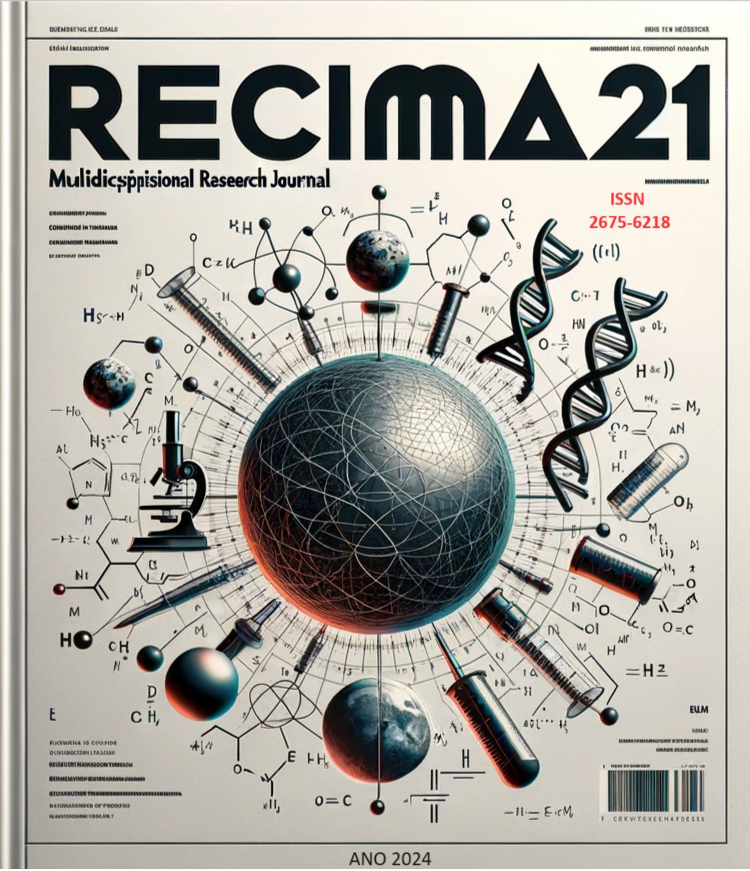PERFIL DE COMPOSTOS POLIFENÓLICOS EXTRAÍDOS DO ORÉGANO (ORIGANUM VULGARE) EM DIFERENTES PERÍODOS DE DECOCÇÃO
DOI:
https://doi.org/10.47820/recima21.v5i6.5311Palavras-chave:
Decocto. ESI-MS. Fitoquímica.Resumo
O orégano (Origanum vulgare) é uma erva utilizada na culinária na forma desidratada, como condimento no preparo dos alimentos. Na medicina tradicional esta erva é utilizada na forma de chás como tônico estimulante, para o alívio de tosse e dores de dente, ouvido e cabeça. Pode ainda, ser empregada para tratar febre, doenças de pele, problemas digestivos e respiratórios. Os principais metabólitos secundários desta espécie pertencem a classe dos monoterpenos e compostos fenólicos, dentro os quais há vários princípios biologicamente ativos, justificando o seu emprego como fitofármaco. Para avaliar o efeito do processo de cozimento sobre os princípios ativos presentes nesta erva, amostras de orégano fresco foram coletadas, secas, e submetidas a decocção por períodos que variaram de 5 a 40 minutos. O perfil dos extratos obtidos foi analisado por Espectrometria de Massas com Ionização por Eletrospray (ESI-MS). A análise dos resultados evidenciou que o perfil químico das amostras, obtidas por decocção, pode ser dividida em dois grupos distintos em função do tempo: um grupo com os tempos de 5,10 e 20 minutos e outro de 30 e 40 minutos. Os resultados mostraram que o perfil químico foi semelhante dentro de cada um dos grupos, porém, diferiram entre os grupos. As amostras pertencentes ao segundo grupo, ou seja, aquelas que foram submetidas a maior tempo de cozimento apresentam grande intensificação dos sinais de massas moleculares correspondentes aos flavonóides glicosilados, possibilitando concluir que o aumento do tempo de decocção favorece a extração destas substâncias cujas propriedades antioxidantes são reconhecidas.
Downloads
Referências
ABE, L. T.; LAJOLO, F. M.; GENOVESE, M. I. Comparison of Phenol Content and Antioxidant Capacity of Nuts. Ciência e Tecnologia de Alimentos, v. 30, p. 254-259, 2010. DOI: https://doi.org/10.1590/S0101-20612010000500038. DOI: https://doi.org/10.1590/S0101-20612010000500038
BENALI, T. et al. Pharmacological insights into the multifaceted biological properties of quinic acid. Biotechnology & Genetic Engineering Reviews, v. 19, p. 1-30, 2022. DOI: https://doi.org/10.1080/02648725.2022.2122303. DOI: https://doi.org/10.1080/02648725.2022.2122303
BIESAGA, M. Influence of extraction methods on stability of flavonoids. Journal of Chromatography A, v. 1218, n. 18, p. 2505-2512, 2011. DOI: https://doi.org/10.1016/j.chroma.2011.02.059. DOI: https://doi.org/10.1016/j.chroma.2011.02.059
CORDEIRO, S. Z. Origanum vulgare L. Herbário. Rio de Janeiro: Unirio, 2011. https://www.origanumvulgareL. Acessado em: 15 jun. 23.
HRNCIC, M. K. et al. Extraction Techniques and Analytical Methods for Characterization of Active Compounds in Origanum Species. Molecules, v. 25, p. 4735, 2020. DOI: https://doi.org/10.3390/molecules25204735. DOI: https://doi.org/10.3390/molecules25204735
IRAKLI, M. et al. LC-MS Identification and Quantification of Phenolic Compounds in Solid Residues from the Essential Oil Industry. Antioxidants, v. 10, n. 12, p. 2016, 2021. DOI: https://doi.org/10.3390/antiox10122016. DOI: https://doi.org/10.3390/antiox10122016
MA, L.; TANG, L.; YI, Q. Salvianolic Acids: Potential Source of Natural Drugs for the Treatment of Fibrosis Disease and Cancer. Front Pharmacology, v. 10, p. 97, 2019. DOI: https://doi.org/10.3389/fphar.2019.00097. DOI: https://doi.org/10.3389/fphar.2019.00097
MENEZES, J. C. J. et al. Volatile compounds and quality analysis in commercial medicinal plants of Camellia sinensis. Ciência Rural, v. 49, n. 03, p. e20180548, 2019. DOI: https://doi.org/10.1590/0103-8478cr20180548. DOI: https://doi.org/10.1590/0103-8478cr20180548
NASCIMENTO, Y. E. Influência da natureza do solvente e do aquecimento na extração de terpenos bioativos de sementes de sucupira branca (Pterodon emarginatus). In: XXX Encontro Regional da Sociedade Brasileira de Química, 2016.
PEZZANI, R.; VITALINI, S.; IRITI, M. Bioactivities of Origanum vulgare L.: an update. Phytochemistry Reviews, v. 16, p. 1253-1268, 2017. DOI: https://doi.org/10.1007/s11101-0179535-z. DOI: https://doi.org/10.1007/s11101-017-9535-z
QIN, T. et al. Salvianolic acid A & B: potential cytotoxic polyphenols in battle against cancer via targeting multiple signaling pathways. International Journal of Biological Science, v. 15, n. 10, p. 2256–2264, 2019. DOI: doi: https://doi.org/10.7150/ijbs.37467. DOI: https://doi.org/10.7150/ijbs.37467
SILVA, J. P. L. et al. Oregano essential oil: influence of the chemical composition on the inhibitory activity against Salmonella enteritidis. Ciência & Tecnologia de Alimentos, v. 30, p. 136-141, 2010. DOI: https://doi.org/10.1590/S0101-20612010000500021. DOI: https://doi.org/10.1590/S0101-20612010000500021
SIMÕES, C. M. O. Farmacognosia – da Planta ao Medicamento. Florianopolis: Editora da UFSC, 2000.
SINGH, P.; KOTHIYAL, P.; RATAN, P. Pharmacological and phytochemical studies of Origanum vulgare: a review. International Research Journal of Pharmacy, [S. l.], v. 9, n. 6, p. 30-35, 2018. DOI: https://doi.org/10.7897/2230-8407.09685. DOI: https://doi.org/10.7897/2230-8407.09685
SOLTANI, S. et al. Review of the Phytochemistry and Antimicrobial Properties of Origanum vulgare L. and Subspecies. Iranian Journal of Pharmaceutical Research, v. 20, n. 2, p. 268-285, 2021. DOI: https://doi.org/10.22037/ijpr.2020.113874.14539.
YI LEI NGO, Y. L.; LAU, C. H.; CHUA, L. S. Review on rosmarinic acid extraction, fractionation and its anti-diabetic potential. Food and Chemical Toxicology, v. 121, p. 687-700, 2018. DOI: https://doi.org/10.1016/j.fct.2018.09.064. DOI: https://doi.org/10.1016/j.fct.2018.09.064
ZEJLI, H. et al. Phytochemical analysis, antioxidant, anti-inflamatory, hemagglutinin and hemolytic activities of chemically characterized extracts from Origanum grossi (L.) and Thymus pallidus (L.). Plants, v. 13, p. 385, 2024. DOI: https://doi.org/10.3390/plants13030385. DOI: https://doi.org/10.3390/plants13030385
Downloads
Publicado
Licença
Direitos de Autor (c) 2024 RECIMA21 - Revista Científica Multidisciplinar - ISSN 2675-6218

Este trabalho encontra-se publicado com a Licença Internacional Creative Commons Atribuição 4.0.
Os direitos autorais dos artigos/resenhas/TCCs publicados pertecem à revista RECIMA21, e seguem o padrão Creative Commons (CC BY 4.0), permitindo a cópia ou reprodução, desde que cite a fonte e respeite os direitos dos autores e contenham menção aos mesmos nos créditos. Toda e qualquer obra publicada na revista, seu conteúdo é de responsabilidade dos autores, cabendo a RECIMA21 apenas ser o veículo de divulgação, seguindo os padrões nacionais e internacionais de publicação.













